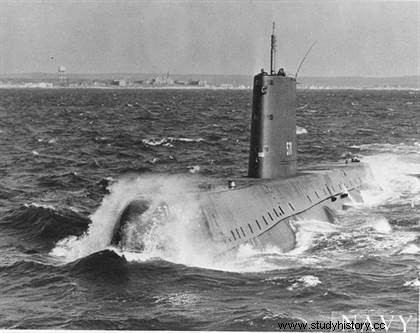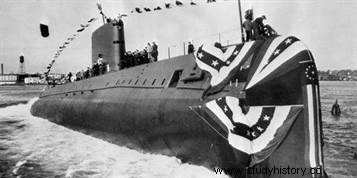 In 1954, the Americans launched the first nuclear-powered submarine , the Nautlus . Its submerged cruising speed is over 20 knots, with virtually unlimited range. In early August 1958, the Nautilus made the first passage under the North Pole, sailing under the ice from Point Barrow, Alaska to a point between Svalbard, Norway and Greenland.
In 1954, the Americans launched the first nuclear-powered submarine , the Nautlus . Its submerged cruising speed is over 20 knots, with virtually unlimited range. In early August 1958, the Nautilus made the first passage under the North Pole, sailing under the ice from Point Barrow, Alaska to a point between Svalbard, Norway and Greenland.
The Nautilus, an old dream
Launched on January 21, 1954, the Nautilus is 98 meters long and weighs more than 3,500 tons. Able to sail at up to 23 knots (43 km/h), it manages in the following years to cover nearly 170,000 kilometers (91,324 nautical miles), including 146,000 kilometers (78,885 nautical miles) under water, before having to reload. its fuel. It thus becomes the first submarine to realize the old dream of Jules Verne:to perform "twenty thousand leagues under the sea" (about 110,000 kilometers). On July 23, 1958, the Nautilus left the port of Pearl Harbor to carry out a secret mission, Operation Sunshine, and headed north. On August 3, it reached its goal and became the first submersible vessel to sail under the ice of the Arctic and pass the North Pole.
 Armed by 13 officers and 92 crew, the Nautilus carried out numerous exercises throughout its history in the Atlantic Ocean and in the Mediterranean and participated in particular in the blockade of Cuba in 1962. In 1980, the submarine was withdrawn from active service after having traveled nearly a million kilometers (more than 500,000 nautical miles). Two years later, it was decided to transform it so that it could be visited by the public. After three years of work, she was finally moored near Groton, Connecticut. It is one of the highlights of the US Submarine Force Museum.
Armed by 13 officers and 92 crew, the Nautilus carried out numerous exercises throughout its history in the Atlantic Ocean and in the Mediterranean and participated in particular in the blockade of Cuba in 1962. In 1980, the submarine was withdrawn from active service after having traveled nearly a million kilometers (more than 500,000 nautical miles). Two years later, it was decided to transform it so that it could be visited by the public. After three years of work, she was finally moored near Groton, Connecticut. It is one of the highlights of the US Submarine Force Museum.
To go further
History of submarines, from their origins to the present day, by Alexandre Sheldon-Duplaix. Techinques Editions, February 2018.
